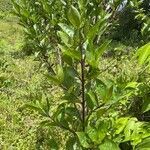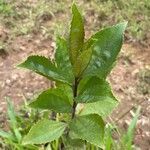cm long, overtopping the foliage; bracts small or scalelike; pedicels to 20 mnu long, slender, drying strongly angled, ebracteolate. Pistillate heads discoid with campanulate involucres 4-5 mm long; involucral bracts loosely imbricate in several unequal series, the innermost narrowly oblong without distinct venation, exceeding the pappus, the remainder obtuse or rounded with ciliate to erose margins, indurate, stramineous except for the short green midvein visible in the upper portion; receptacle 5-6 mm across, flat, muricate and short-paleaceous, becoming blackish; florets ca. 5 mm long, the corolla white, slender, tubular-corniculate, tapering from a broad base to the erose-margined apex, sparingly pubescent, the style exserted, its branches linear-obtuse, flattened, glandular papillose on the dorsal surface, the ovary glabrous except for a ring of short bristles near the base. Staminate heads discoid, smaller than the pistillate; receptacle flat, naked, often not blackening; florets 6 mm long, the corolla tube sparingly pubescent upwards, the limb ca. 2.5 mm long, lobed about halfway, the lobes acute or obtuse with thickened margins, the anthers 1.2 mm long, little exserted, basally slightly auricled, the appendages short-deltoid, the style densely glandular pilose upwards, its branches linear, papillose-pilose, the ovary (sterile) less than half as long as ovaries of the pistillate florets. Achene angled with a ring of short bristles at the base; pappus of fine, smooth or strigulose bristles in one series, buff colored.
More
Glabrate shrub to 4 m tall; branches ascending, sometimes with conspicuous leaf scars, drying with many longitudinal striations and angles, often dark and somewhat reddish; emergent parts resinous. Leaves to 12 cm long, entire, elliptical, basally obtuse or acute, apically acute, acuminate or rounded and mucronate, beneath with 3(-7) prominent, elevated, stramineous, parallel nerves and finely reticulate, above with more or less obscure venation or a series of pinnate veins, glabrous, often resinous; petioles to 20 mm long, pubescent on the ventral surface, sometimes sharply angled. Inflorescence a corymb or panicle of many heads, to 15


